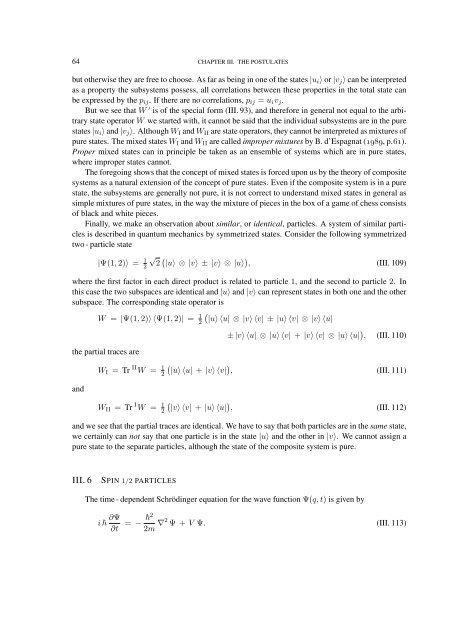FOUNDATIONS OF QUANTUM MECHANICS
FOUNDATIONS OF QUANTUM MECHANICS
FOUNDATIONS OF QUANTUM MECHANICS
Create successful ePaper yourself
Turn your PDF publications into a flip-book with our unique Google optimized e-Paper software.
64 CHAPTER III. THE POSTULATES<br />
but otherwise they are free to choose. As far as being in one of the states |u i ⟩ or |v j ⟩ can be interpreted<br />
as a property the subsystems possess, all correlations between these properties in the total state can<br />
be expressed by the p ij . If there are no correlations, p ij = u i v j .<br />
But we see that W ′ is of the special form (III. 93), and therefore in general not equal to the arbitrary<br />
state operator W we started with, it cannot be said that the individual subsystems are in the pure<br />
states |u i ⟩ and |v j ⟩. Although W I and W II are state operators, they cannot be interpreted as mixtures of<br />
pure states. The mixed states W I and W II are called improper mixtures by B. d’Espagnat (1989, p.61).<br />
Proper mixed states can in principle be taken as an ensemble of systems which are in pure states,<br />
where improper states cannot.<br />
The foregoing shows that the concept of mixed states is forced upon us by the theory of composite<br />
systems as a natural extension of the concept of pure states. Even if the composite system is in a pure<br />
state, the subsystems are generally not pure, it is not correct to understand mixed states in general as<br />
simple mixtures of pure states, in the way the mixture of pieces in the box of a game of chess consists<br />
of black and white pieces.<br />
Finally, we make an observation about similar, or identical, particles. A system of similar particles<br />
is described in quantum mechanics by symmetrized states. Consider the following symmetrized<br />
two - particle state<br />
|Ψ(1, 2)⟩ = 1 2<br />
√<br />
2<br />
(<br />
|u⟩ ⊗ |v⟩ ± |v⟩ ⊗ |u⟩<br />
)<br />
, (III. 109)<br />
where the first factor in each direct product is related to particle 1, and the second to particle 2. In<br />
this case the two subspaces are identical and |u⟩ and |v⟩ can represent states in both one and the other<br />
subspace. The corresponding state operator is<br />
W = |Ψ(1, 2)⟩ ⟨Ψ(1, 2)| = 1 (<br />
2 |u⟩ ⟨u| ⊗ |v⟩ ⟨v| ± |u⟩ ⟨v| ⊗ |v⟩ ⟨u|<br />
the partial traces are<br />
and<br />
W I = Tr II W = 1 2<br />
W II = Tr I W = 1 2<br />
± |v⟩ ⟨u| ⊗ |u⟩ ⟨v| + |v⟩ ⟨v| ⊗ |u⟩ ⟨u| ) , (III. 110)<br />
(<br />
|u⟩ ⟨u| + |v⟩ ⟨v|<br />
)<br />
, (III. 111)<br />
(<br />
|v⟩ ⟨v| + |u⟩ ⟨u|<br />
)<br />
, (III. 112)<br />
and we see that the partial traces are identical. We have to say that both particles are in the same state,<br />
we certainly can not say that one particle is in the state |u⟩ and the other in |v⟩. We cannot assign a<br />
pure state to the separate particles, although the state of the composite system is pure.<br />
III. 6<br />
SPIN 1/2 PARTICLES<br />
The time - dependent Schrödinger equation for the wave function Ψ(q, t) is given by<br />
i ∂Ψ<br />
∂t<br />
= − 2<br />
2m ∇2 Ψ + V Ψ. (III. 113)
















